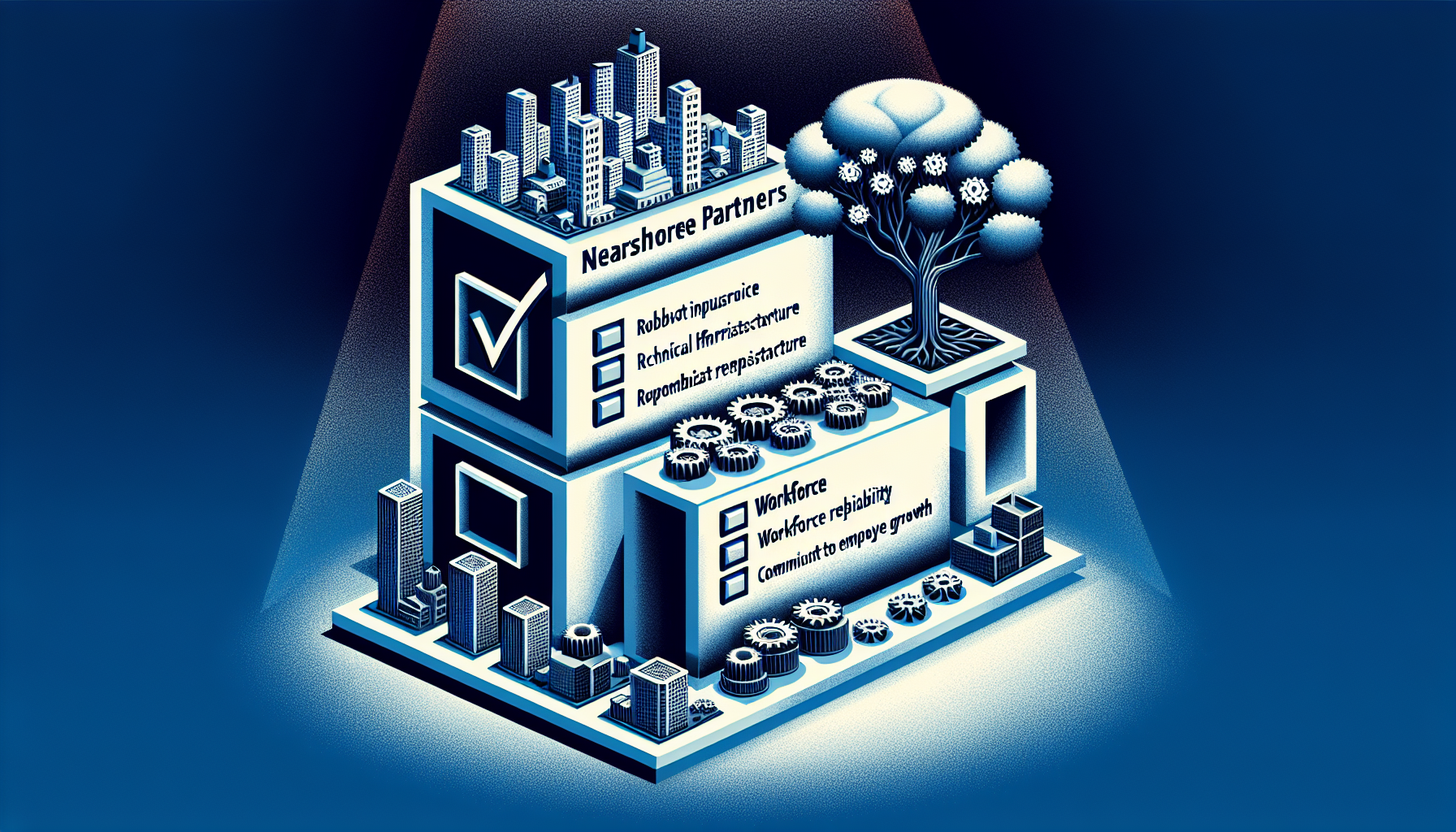Are you leveraging “Nearshore: An Opportunity for Professional Development”? In today’s interconnected world, nearshoring is more than a business strategy; it’s a platform for skill enhancement and career growth. This article addresses how engaging with nearshore environments can broaden your technical knowledge, sharpen project management techniques, and deepen your cross-cultural understanding—all integral to driving professional success.
Key Takeaways
- Nearshore software development offers significant professional development opportunities, including enhancing technical and project management skills, and improving language proficiency and communication in international markets.
- The synergy between nearshore development and career training enhances career growth and competitiveness through access to a larger talent pool, integration of learning with work, and networking opportunities.
- Cultural exchange in nearshore outsourcing is crucial for professional growth, fostering understanding and strengthening international relationships, while the right choice of nearshore partner is essential for long-term career advancement.
Exploring Professional Development through Nearshore Software Development

As we delve deeper into the benefits of nearshore software development, we’ll explore three key areas: enhancing technical skills, cultivating project management expertise, and the advantages of language proficiency and communication. Each of these represents a unique facet of professional development opportunities that nearshore development provides.
Enhancing Technical Skills with Nearshore Projects
The realm of nearshore software development projects offers a unique opportunity for IT professionals to enhance their technical skill set. Here are some benefits of working on nearshore projects:
- Exposure to a diverse range of technologies and programming languages
- Opportunity to work with international coding standards and practices
- Chance to collaborate with a global team
These experiences can propel your technical capabilities to a global level.
This engagement with varied working styles and methodologies cultivates adaptability and problem-solving skills, adding another feather to your professional cap. Furthermore, working with nearshore teams often necessitates the utilization of different project management tools, building your proficiency in these essential software platforms: Asana, Basecamp and others.
By using these tools and implementing various project management approaches, you can enhance your project management skills and become more efficient in your work.
Cultivating Project Management Expertise
The world of nearshore projects is a project manager’s playground. The Agile approach, often employed in such projects, offers hands-on experience in organizing work into sprints and facilitating daily stand-up meetings. This exposure to Agile or Scrum methodologies broadens your project management expertise. Collaboration tools such as Slack, Asana, and Jira, commonly used in nearshore teams, further enhance your project management and communication skills.
The ability to manage distributed teams and effectively handle cross-border projects are critical skills that you can develop and refine through nearshore software development.
Language Proficiency and Communication Advantages
The ability to communicate effectively is a vital skill in today’s globalized world. Collaboration with nearshore partners offers an excellent platform for improving language proficiency, often necessitating learning the basics of different languages. English education in Latin American regions aids in reducing communication barriers, with English becoming a common language in the business realm of these countries. As you immerse yourself in environments where conveying complex technical concepts across cultural boundaries is commonplace, you’ll find your communication skills improving.
Cultural sensitivity and flexibility in communication styles are nurtured as global teams work to integrate different perspectives, further enhancing your professional development.
The Synergy Between Nearshore Development and Career Training
Delving into the heart of nearshore development in Latin America, we find a competitive advantage in quality and innovation. This advantage not only enhances professional development for the outsourcing company but also boosts growth for the local workforce. Advancing your career and staying competitive in your field greatly depend on engaging in professional development. It is a crucial factor that can significantly impact your success. The synergy between nearshore development and career training is a potent combination that can propel your professional growth to new heights.
As we uncover the potential of nearshore development for career training, we’ll explore:
- The benefits of access to a larger talent pool
- The integration of online courses with on-the-job learning
- The opportunities that arise from networking events and collaboration tools.
Access to a Larger Talent Pool
Nearshoring presents an opportunity to tap into a large talent pool of skilled professionals in Latin America. This access opens doors for career growth and participation in high-profile projects. The education systems in Latin America prioritize IT and software development, leading to a robust network of skilled tech talent in the region. Moreover, the cost savings associated with nearshore outsourcing enables companies to expand their talent pool without incurring high recruitment and training costs.
Renowned for its highly educated workforce, Argentina’s software development sector contributes significantly to the global technology landscape.
Integrating Online Courses with On-the-Job Learning
The synergy between nearshore development and career training is further amplified when online courses are integrated with on-the-job learning. Nearshore development environments often promote mentorship programs, enhancing the learning experience.
This mentorship in nearshore projects facilitates the transfer of tacit knowledge, seamlessly complementing formal online education.
Networking Events and Collaboration Tools
Networking is a powerful tool for establishing relationships, uncovering career advancement opportunities, and gaining industry insights. Attending conferences, workshops, and seminars provides a platform to explore new ideas and perspectives. Nearshore development companies often partake in such events, which serve as fertile ground for networking and professional development.
Building a network through nearshore partnerships can unlock future career opportunities and collaborations in new markets and industries. Collaboration tools like: Salck, Zoom, TRello, Jira and Microsoft Teams.
Enable teams to work seamlessly across geographical boundaries, improving project tracking and facilitating efficient feedback loops. These tools streamline communication and enhance collaboration in distributed work environments.
Cost-Effective Strategies for Skill Enhancement via Nearshore Outsourcing
The cost-effectiveness of nearshore outsourcing is undeniable. It offers a path for skill enhancement that includes lower operating expenses, access to skilled specialists, and closing skill gaps in your development processes. Nearshoring to Mexico, for instance, provides substantial cost advantages for software development projects with lower operating expenses, including reductions in utility, administrative overhead, infrastructure, and recruitment costs. Companies in the United States can save up to 50% on development costs by partnering with nearshore firms in Mexico or Costa Rica, offering cost-effective rates without the complications of logistical and communication issues.
In this section, we’ll explore how you can achieve cost savings while upskilling and balance project work with development opportunities, all through the strategic use of nearshore outsourcing.
Achieving Cost Savings While Upskilling
Nearshore development is a win-win strategy that allows companies to hire skilled developers at reduced rates, making it a cost-effective avenue for professional upskilling. Regions like Latin America provide nearshore software development services at competitive pricing, offering a cost-effective avenue for professional development.
The lower costs associated with nearshore regions enable companies to access a larger and more varied talent pool, enhancing the opportunity for professional upskilling.
Balancing Project Work with Development Opportunities
Outsourcing to nearshore teams and offshore outsourcing can result in a more balanced workload by adopting an effective outsourcing model. This balance provides employees with opportunities to engage in professional development. Continuously upskilling and learning new technologies is vital to remain competitive in the job market.
The proximity of nearshore outsourcing partners can lead to more efficient work processes and faster delivery of software projects.
Understanding the Role of Cultural Exchange in Professional Growth
The role of cultural exchange in professional growth is multifaceted. Nearshore partnerships enhance personal self-awareness and foster stronger international professional relationships. These cross-cultural interactions often lead to durable professional networks and opportunities that contribute to career advancement. By partnering with culturally similar countries, nearshore development encourages cultural compatibility, which is essential for a smooth professional collaboration.
In this section, we’ll delve into:
- Overcoming cultural differences for project success
- Building cultural understanding and alignment
- Leveraging real-time communication for cultural integration
Overcoming Cultural Differences for Project Success
Working in a culturally diverse environment can be challenging, but the rewards are significant. Cultural sensitivity training enhances team members’ understanding of different cultural norms, communication styles, and business etiquettes, which is crucial for smoother project execution. Awareness of varying attitudes towards hierarchy and power dynamics within the team ensures a comfortable environment where all members feel confident to contribute.
Professional exposure to diverse cultures through nearshore partnerships allows for gaining deeper insights into various concerns and aspirations, enhancing problem-solving skills and adaptability.
Building Cultural Understanding and Alignment
Building cultural understanding and alignment in nearshore teams is an integral part of professional development. Nearshore software development leverages cultural similarities, such as shared references and familiarity with US commerce and pop culture, to enhance networking and use of collaboration tools effectively. Cultural and geographical proximity in nearshore locations supports smoother integration and alignment of teams, aiding in continuous professional development.
Acknowledging cultural and personality differences sparks new perspectives and innovation, while cultural awareness strengthens rapport and work relationships within global teams.
Leveraging Real-Time Communication for Cultural Integration
Real-time communication is a key factor in cultural integration within nearshore projects. Time zone alignment in nearshore software development projects facilitates synchronous working hours, enabling real-time communication crucial for efficient collaboration.
Real-time communication allows for:
- the organization of regular live meetings
- daily communication during business hours
- improving agile development practices
- decision-making
- maintaining project momentum.
The cultural exchange enabled by real-time communication strengthens interpersonal and communication abilities among team members, helping them overcome cultural and language barriers.
Selecting the Right Nearshore Partner for Professional Advancement

- Look for a nearshore partner with a record of internal promotion, as this indicates their investment in employee growth.
- Choose a nearshore partner that has a structured system for career development, ensuring clear pathways for professional advancement.
- Prioritize a nearshore company that values mentorship and coaching, as this creates a robust environment for ongoing professional learning and skill development.
In this section, we’ll cover the following topics:
- Criteria for assessing nearshore partners
- Establishing clear goals with your nearshore team
- Evaluating the long-term benefits of nearshore relationships
Criteria for Assessing Nearshore Partners
Choosing a nearshore partner requires careful consideration of several key factors. When selecting a nearshore partner, it is crucial to:
- Assess the technical infrastructure
- Understand the project goals, technical needs, and capabilities
- Inquire about the partner’s internet connectivity, hardware, and software capabilities to ensure a supportive technology environment
These factors are essential to project success.
Evaluating workforce reliability and talent retention is critical for ensuring a stable and knowledgeable team for your projects.
Establishing Clear Goals with Your Nearshore Team
Once you’ve chosen the right nearshore partner, it’s time to establish clear goals with your nearshore team. Establish a shared vision by aligning the nearshore team’s objectives with your organization’s strategic goals. Prepare clear, concise expectations for the project including requirements, milestones, quality standards, and communication methods to guide the nearshore team’s efforts.
Regularly reviewing project milestones and individual performance ensures that the nearshore team members are progressing towards their professional development objectives.
Evaluating the Long-Term Benefits of Nearshore Relationships
Evaluating the long-term benefits of nearshore relationships is crucial for future growth. Nearshore partners that provide annual investment in ongoing training contribute significantly to the long-term development of skills for their employees. A committed nearshore partner that fosters a strong culture facilitates the creation of a productive and dedicated team, essential for long-term success.
Choosing a nearshore partner that includes profit-sharing in its business model can ensure a deep-seated interest in the collective success of projects, reaping long-term relational benefits.
Leveraging Latin America’s Nearshore Potential for Professional Development
Latin America is a region brimming with nearshore potential. It offers a diverse array of software development capacities, strengths, and opportunities for professional development. Countries like Mexico are praised for their talented IT professionals and are cost-effective options for nearshore software development. Mexico’s highly skilled workforce is the result of a dedication to continuous learning and adaptability, as well as proficiency in diverse software development disciplines. This combination of attributes allows for a strong and flexible talent pool..
In this section, we’ll:
- Explore why Latin America is a hotspot for tech talent
- Examine notable nearshore locations in Latin America
- Share success stories of career growth through Latin American partnerships.
Why Latin America Is a Hotspot for Tech Talent
Latin America is a rising star in the world of tech talent. It offers a combination of technological proficiency, cultural affinity, and economic benefits, which include large talent pools and lower labor costs enhanced by innovative legislation and initiatives fostering growth in tech talent pools. The tech talent in the region is increasingly diverse with countries like Chile and Uruguay joining Argentina and Brazil in contributing to a vast, skilled labor pool in Latin America.
Countries like Argentina and Brazil, among others, are known for their robust digital talent, positioning Latin America as a leading location for skilled software developers.
Examining Notable Nearshore Locations in Latin America
Latin America is not a homogeneous region, and its nearshore locations offer diverse software development capacities and strengths. Some key countries to consider for nearshoring include:
- Brazil, which leads in the number of software developers
- Mexico, which is recognized for its high-quality IT education
- Argentina, whose workforce is renowned for their education and strong integration in app development communities
- Colombia, which has seen a surge in tech program graduates driven by its digital economy
These countries offer a robust technical foundation for nearshoring and can provide valuable resources for software development projects.
Uruguay, Chile, and Peru are increasingly favored nearshore locations due to their minimal language barriers, superior technical education, dynamic IT sectors, startup-friendly culture, and business conducive environments.
Success Stories: Career Growth through Latin American Partnerships
Success stories of career growth through Latin American partnerships provide a real-world glimpse into the potential of nearshore collaborations. The nearshoring trend in Latin America has enabled many US and Canadian companies to engage with software developers and tech talent, leading to mutual professional development and growth.
A case study involving Scio and CPH & Associates demonstrated how nearshore partnerships between Latin American software companies and clients lead to mutual understanding, trust, and successful software development outcomes.
Exploring the world of nearshore software development has been a journey of discovery, revealing the potential for personal and professional growth. We’ve delved into the benefits of nearshore software development, examined the synergy between nearshore development and career training, discussed cost-effective strategies for skill enhancement, and explored the role of cultural exchange in professional growth. We’ve also provided guidance on selecting the right nearshore partner, and highlighted the potential of Latin America as a hotspot for nearshore development and tech talent. As we conclude this exploration, remember that every step taken towards understanding nearshore software development is a step towards your personal and professional evolution.
Frequently Asked Questions
What is the meaning of the word nearshore?
Nearshore means extending from or occurring along a shore, often in the context of activities or conditions related to the waters near the shore.
What are the benefits of nearshore sourcing?
Nearshore sourcing offers benefits such as access to qualified talent, cost reductions, streamlined workflows, operational control, cultural affinity, and opportunities to enhance service offerings. Consider these advantages when evaluating your sourcing options.
What is considered nearshore?
In the context of outsourcing, nearshore refers to countries in close proximity with similar time zones, such as Mexico for the United States, while offshore refers to far-away countries with considerable time zone differences, like India for the United States.
What is nearshore software development?
Nearshore software development involves outsourcing software development work to teams in nearby countries, typically within the same or similar time zones. It offers geographical proximity and easier collaboration.
What is the role of cultural exchange in professional growth?
Cultural exchange in nearshore partnerships enhances self-awareness and fosters stronger international professional relationships. This can lead to a significant impact on professional growth.



0 Comments